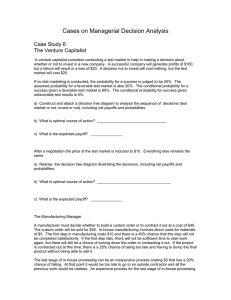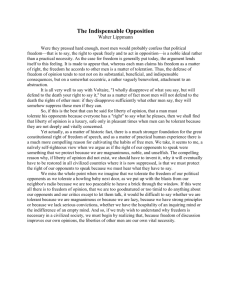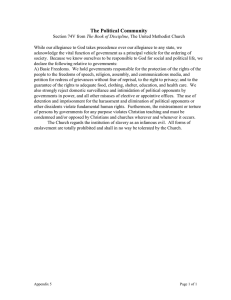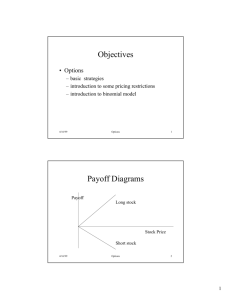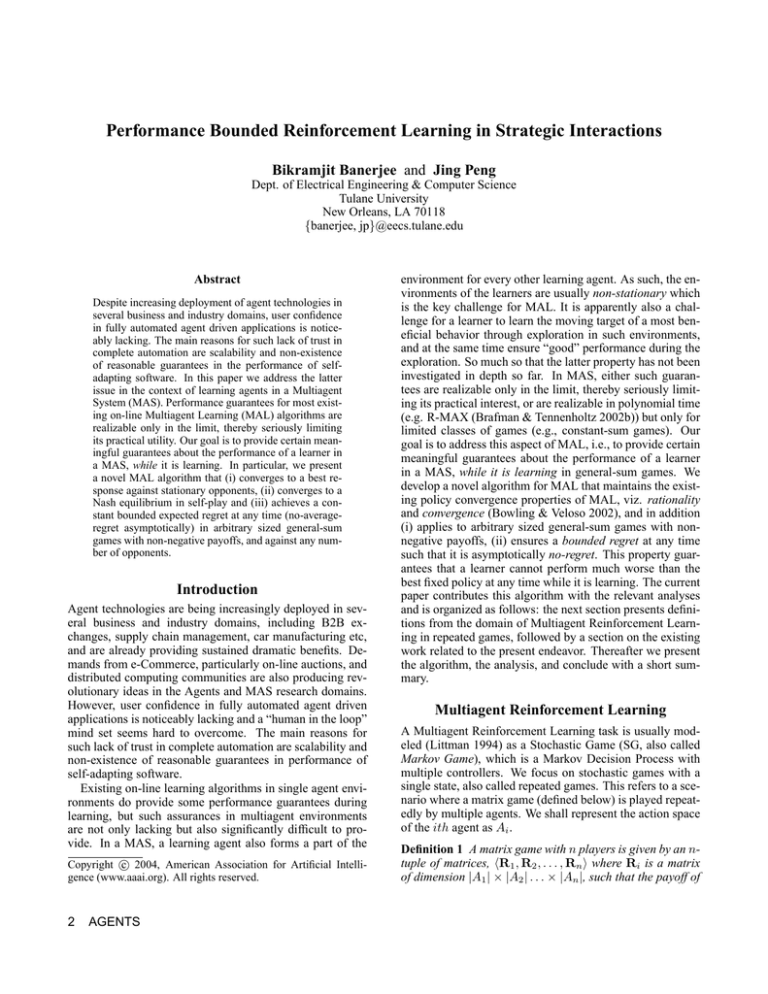
Performance Bounded Reinforcement Learning in Strategic Interactions
Bikramjit Banerjee and Jing Peng
Dept. of Electrical Engineering & Computer Science
Tulane University
New Orleans, LA 70118
{banerjee, jp}@eecs.tulane.edu
Abstract
Despite increasing deployment of agent technologies in
several business and industry domains, user confidence
in fully automated agent driven applications is noticeably lacking. The main reasons for such lack of trust in
complete automation are scalability and non-existence
of reasonable guarantees in the performance of selfadapting software. In this paper we address the latter
issue in the context of learning agents in a Multiagent
System (MAS). Performance guarantees for most existing on-line Multiagent Learning (MAL) algorithms are
realizable only in the limit, thereby seriously limiting
its practical utility. Our goal is to provide certain meaningful guarantees about the performance of a learner in
a MAS, while it is learning. In particular, we present
a novel MAL algorithm that (i) converges to a best response against stationary opponents, (ii) converges to a
Nash equilibrium in self-play and (iii) achieves a constant bounded expected regret at any time (no-averageregret asymptotically) in arbitrary sized general-sum
games with non-negative payoffs, and against any number of opponents.
Introduction
Agent technologies are being increasingly deployed in several business and industry domains, including B2B exchanges, supply chain management, car manufacturing etc,
and are already providing sustained dramatic benefits. Demands from e-Commerce, particularly on-line auctions, and
distributed computing communities are also producing revolutionary ideas in the Agents and MAS research domains.
However, user confidence in fully automated agent driven
applications is noticeably lacking and a “human in the loop”
mind set seems hard to overcome. The main reasons for
such lack of trust in complete automation are scalability and
non-existence of reasonable guarantees in performance of
self-adapting software.
Existing on-line learning algorithms in single agent environments do provide some performance guarantees during
learning, but such assurances in multiagent environments
are not only lacking but also significantly difficult to provide. In a MAS, a learning agent also forms a part of the
c 2004, American Association for Artificial IntelliCopyright gence (www.aaai.org). All rights reserved.
2
AGENTS
environment for every other learning agent. As such, the environments of the learners are usually non-stationary which
is the key challenge for MAL. It is apparently also a challenge for a learner to learn the moving target of a most beneficial behavior through exploration in such environments,
and at the same time ensure “good” performance during the
exploration. So much so that the latter property has not been
investigated in depth so far. In MAS, either such guarantees are realizable only in the limit, thereby seriously limiting its practical interest, or are realizable in polynomial time
(e.g. R-MAX (Brafman & Tennenholtz 2002b)) but only for
limited classes of games (e.g., constant-sum games). Our
goal is to address this aspect of MAL, i.e., to provide certain
meaningful guarantees about the performance of a learner
in a MAS, while it is learning in general-sum games. We
develop a novel algorithm for MAL that maintains the existing policy convergence properties of MAL, viz. rationality
and convergence (Bowling & Veloso 2002), and in addition
(i) applies to arbitrary sized general-sum games with nonnegative payoffs, (ii) ensures a bounded regret at any time
such that it is asymptotically no-regret. This property guarantees that a learner cannot perform much worse than the
best fixed policy at any time while it is learning. The current
paper contributes this algorithm with the relevant analyses
and is organized as follows: the next section presents definitions from the domain of Multiagent Reinforcement Learning in repeated games, followed by a section on the existing
work related to the present endeavor. Thereafter we present
the algorithm, the analysis, and conclude with a short summary.
Multiagent Reinforcement Learning
A Multiagent Reinforcement Learning task is usually modeled (Littman 1994) as a Stochastic Game (SG, also called
Markov Game), which is a Markov Decision Process with
multiple controllers. We focus on stochastic games with a
single state, also called repeated games. This refers to a scenario where a matrix game (defined below) is played repeatedly by multiple agents. We shall represent the action space
of the ith agent as Ai .
Definition 1 A matrix game with n players is given by an ntuple of matrices, hR1 , R2 , . . . , Rn i where Ri is a matrix
of dimension |A1 | × |A2 | . . . × |An |, such that the payoff of
the ith agent for the joint action (a1 , a2 , . . . , an ) is given by
the entry Ri (a1 , a2 , . . . , an ), ∀i.
A constant-sum game (also called
P competitive games) is
a special matrix gameQwhere
i Ri (a1 , a2 , . . . , an ) =
c, ∀(a1 , a2 , . . . , an ) ∈ k Ak , c being a constant. If c = 0,
then it is also called a zero-sum game. An example of such a
game with 2 players appears in Table 1. This game is called
Rock-Scissor-Paper. Here A1 = A2 = {R, S, P } and the
game payoffs for any joint action sum to 0 as shown in Table 1.
Table 1: Rock-Scissor-Paper Game. (a, b) in the (i, j)th
cell is the tuple of payoffs for Row agent and Column agent
(in that order) for each combination of their actions (i, j) ∈
{R, S, P } × {R, S, P }.
Actions
Rock (R)
Scissor (S)
Paper (P)
Rock (R)
(0,0)
(-1,1)
(1,-1)
Scissor (S)
(1,-1)
(0,0)
(-1,1)
Paper (P)
(-1,1)
(1,-1)
(0,0)
A mixed policy, vector π i ∈ P D(Ai ) for agent i, is
a probability distribution over Ai , where P D is the set
of probability distributions over the action space. If the
entire probability mass is concentrated on a single action (some actions), it is also called a pure policy (partially mixed policy). The joint policies of the opponents
of the ith agent will be given by the vector π −i . We
shall usually refer to the ith agent as the learner and the
rest of the agents as the opponents. The expected payoff of the learner at any stage in which the policy tuple
hπ
π n i is followed is given by Vi (π i , π −i ) =
P 1 , π 2 , . . . ,Q
(a1 ,...,an )∈
Ak π1 (a1 ) . . . πn (an )Ri (a1 , . . . , an ).
k
Definition 2 For an n-player matrix game, the best rei
sponse (BRπ
) of the ith agent to its opponents’ joint
−i
i
policy (π −i ) is given by BRπ
= {π i |Vi (π i , π −i ) ≥
−i
0
0
Vi (π i , π −i ), ∀π i ∈ P D(Ai )}.
Definition 3 A mixed-policy Nash Equilibrium (NE) for a
matrix game hR1 , R2 , . . . , Rn i is a tuple of probability vectors hπ ∗1 , π ∗2 , . . . , π ∗n i (policy profile) such that each is a
i
best response to the rest, i.e., π ∗i ∈ BRπ
∀i. In terms of
∗
−i
payoffs, these conditions can be restated as Vi (π ∗i , π ∗−i ) ≥
Vi (π i , π ∗−i ) ∀π i ∈ P D(Ai ) , ∀i.
No player in this game has any incentive for unilateral deviation from the Nash equilibrium policy, given the others’
policy. There always exists at least one such equilibrium
profile for an arbitrary finite matrix game (Nash 1951). As
an example, the only NE for the 2 player RSP game in Table 1 is [ 31 , 13 , 13 ] and [ 13 , 13 , 13 ] for the two agents.
Definition 4 For a given time range t = 0 . . . T , the regret of a learner (agent i), RgiT is given by RgiT =
Pt=T
Pt=T
maxπ i t=1 Vi (π i , π t−i ) − t=1 Vi (π ti , π t−i ).
This means that if the sum of expected payoffs of the learner
in the given time range against the actual unknown policies
played by the non-stationary opponent were compared to
that of an oracle who knows the actual policies to be played
by the opponent ahead of time and can statically compute
Pt=T
a fixed policy π i that maximizes t=1 Vi (π i , π t−i ) but is
limited to play only that policy all through the time window
T , then the difference would be the former player’s regret.
In hindsight (after t = T ) he finds that always playing π i instead of the sequence {π ti } would have yielded a total payoff
higher than his actual payoff by RgiT .
Related Work
Multiagent Reinforcement Learning has produced primarily two types of algorithms. One type learns some fixed
point of the game e.g., NE (Minimax-Q (Littman 1994;
Littman & Szepesvari 1996), Nash-Q (Hu & Wellman 1998;
2002), FFQ (Littman 2001)) or correlated equilibrium (CEQ (Greenwald & Hall 2002)). These algorithms can guarantee a certain minimal expected payoff asymptotically, but it
may be possible to guarantee higher payoff in certain situations if the learner is adaptive to the opponents’ play,
instead of learning the game solution alone. This brings
us to the other type of learners that learn a best response
to the opponents’ actual play e.g., IGA (Singh, Kearns,
& Mansour 2000), WoLF-IGA (Bowling & Veloso 2001;
2002), AWESOME (Conitzer & Sandholm 2003a). Since
mutual best response is an equilibrium, two similar best responding players (such situations referred to as self-play)
should be able to converge to an equilibrium. WoLF-IGA
achieves this in 2 × 2 games and AWESOME achieves it for
arbitrary sized games. Simple Q-learning (Sutton & Burto
1998) is also capable of learning a best response to an arbitrary opponent’s policy provided that latter is stationary.
Nevertheless, a straightforward application of Q-learning
has been shown to perform well in MAL problems (Tan
1993; Sen, Sekaran, & Hale 1994; Sandholm & Crites 1996;
Claus & Boutilier 1998). There has also been some work on
playing team games (where the game matrices of all agents
are identical) (Claus & Boutilier 1998; Wang & Sandholm
2002) with stronger convergence guarantees owing to the
correlation of the game matrices.
However, the existing literature in MAL seldom provides
any performance guarantees during the learning process.
One significant line of work with possible impact on MAL
in this regard is that on regret matching learners. AlgoRg T
rithms have been proposed that achieve limT →∞ Ti = 0
(called no-regret algorithms) but their convergence properties in policies are unknown (Auer et al. 1995; Fudenberg &
Levine 1995; Freund & Schapire 1999; Littlestone & Warmuth 1994) or at best limited (Jafari et al. 2001). Thus we
see that existing MAL algorithms either do not provide any
performance assurances during learning or they do without
any convergence assurances. Our goal is to achieve both.
Recent work by Zinkevich (2003) shows that IGA (Singh,
Kearns, & Mansour 2000) has a no-regret property (even
with extension to larger games) but this algorithm is not
guaranteed to converge to Nash policies in self-play. Even
WoLF-IGA cannot guarantee convergence to NE in selfplay in larger games (Bowling & Veloso 2002). A more
recent work (Conitzer & Sandholm 2003b) establishes a
bounded loss learning framework (BL-WoLF) in classes of
AGENTS 3
zero-sum games allowing an agent to learn the minimax solution of such a game with the least amount of cumulative
loss against the worst possible opponent (one who knows the
game beforehand). Though this does provide performance
assurances during learning, the framework does not address
general-sum games, or learning adaptive best responses.
There is a fundamentally different notion of equilibrium
from a NE of the one-shot game that we address. This is Efficient Learning Equilibrium (ELE) (Brafman & Tennenholtz
2002a), where the players’ learning algorithms are required
to reach an equilibrium in polynomial time, but which may
not exist under imperfect monitoring settings. Though the
computational complexity of a NE is an open problem, its
advantage is its guaranteed existence. Also, we do not assume perfect monitoring for our work since the learner does
not need to observe the opponents’ payoffs.
Performance Bounded Multiagent Learning
No-regret property is of great interest for MAL domains
since it provides a meaningful performance bound for a
learner in a non-stationary environment. We use this notion
of performance bound for our learning algorithm. Our goal
is to present a MAL algorithm that satisfies the rationality
and convergence criteria of (Bowling & Veloso 2002), i.e.
• Converges to the stationary best response against stationary opponents. This is a base case that ensures consistency of a learning algorithm against non-learners.
• Converges to the NE policy profile of the one-shot game
in repeated self-play of a matrix game.
a learner knows its game payoffs but they can be negative, then he can always imaginably transform that game
into a non-negative game, then compute policy using the
transformed game and use it in playing the actual game.
The expected payoffs will differ only by a constant and
the no-regret property will remain unchanged.
2. that the agents can observe each other’s instantaneous
policies and can use vanishing step sizes for policy improvement (similar to IGA and WoLF-IGA). It can also
observe the expected payoffs of all of its actions at any iteration (trivially computable if game payoffs are known).
3. that the agents are given at the start, their portions of an
equilibrium policy profile which they converge to if all
the agents are following the same prescribed algorithm
(similar to WoLF-IGA and AWESOME).
We write the probability of the jth action of the ith agent
at time t as πit (j) and the expected payoff of this action
against the opponent’s current policy as Vi (j, π t−i ) and note
that
X
πit (j)Vi (j, π t−i ) = Vi (π ti , π t−i ).
(1)
j
The ReDVaLeR Algorithm
We propose to use the Replicator (Fudenberg & Levine
1998) rule for policy update of our target algorithm
with a WoLF-like modification, which we call ReDVaLeR
(Replicator Dynamics with a Variable Learning Rate).
πit+1 (j)
and in addition has the following properties
• Applies to arbitrary sized games, unlike IGA or WoLFIGA.
• Achieves no-regret payoff against any opponent.
AWESOME (Conitzer & Sandholm 2003a) also has the first
3 properties but the case where the opponents are neither
stationary nor following the same algorithm as the learner
has not been dealt with explicitly. In (Conitzer & Sandholm
2003a), when such agents are encountered the learner will
reset repeatedly each time starting off with playing its NE
policy and gradually moving toward a best response until
the next reset. This does not provide any guarantee that its
average payoff will be “good” in such cases. The behavior of
WoLF-IGA in such cases is also unspecified. We posit that
a “good” payoff in such cases is the no regret payoff. We
propose to ensure that in situations where the opponents are
neither stationary, nor following the learner’s algorithm, at
least the learner’s average payoff will approach its no-regret
payoff. This property does not conflict with either rationality
or convergence; in fact they are in agreement since best response payoff (achieved asymptotically in rational and convergent play) cannot be worse than no-regret payoff. We
make the following assumptions for the current work,
1. that either the learner knows its own bounded game payoffs (like AWESOME) or the payoffs are unknown but
non-negative and bounded, i.e., in the range [r, r̄] such
that r ≥ 0. We call such games non-negative games. If
4
AGENTS
= πit (j) + ηπit (j) × [lit (j)Vi (j, π t−i ) −
X
lit (j)πit (j)Vi (j, π t−i )]
(2)
j
for η being a vanishing step size and base condition:
πi0 (j) = |A1i | , learning rates lit (j) are defined later. As
η → 0, the above difference equation yields the following
differential equation 1 for the dynamics of the n-player system
d t
(π (j)) = πit (j) × [lit (j)Vi (j, π t−i ) −
dt i
X
lit (j)πit (j)Vi (j, π t−i )]
(3)
j
j = 1 . . . |Ai |, i = 1 . . . n. This is similar to the Replicator rule except for the learning rates, l. The Replicator Dynamics (RD) (Fudenberg & Levine 1998) have been extensively studied in population genetics and evolutionary game
theory. It is known that the NE may not be asymptotically
stable for RD in many games, e.g., RSP game in Table 1.
A recent result in (Hart & Mas-Colell 2003) explains why.
They show that if the dynamics are uncoupled (as in RD),
i.e., if the agents do not use the opponents’ payoff information in its dynamics, then it is unable to overcome an
“information barrier” and consequently unable to guarantee
convergence. This also explains why IGA (Singh, Kearns,
1
The RHS is discontinuous but we do not need to completely
solve the system. Our approach is only to show that a chosen fixed
point can be made asymptotically stable under the dynamics.
& Mansour 2000) fails to guarantee convergence to NE but
WoLF-IGA succeeds. As in WoLF-IGA, the learning rates l
may be one way to provide the necessary coupling, and we
define lit (j) for ReDVaLeR as
if π t−i is fixed
1
∗j
t
1 + σ if πit (j) < πi
li (j) =
otherwise
1 − σ when πit (j) ≥ πi∗j
(4)
where π ∗i is an NE policy. We typically require a constant 0 < σ 1. We note that when πit (j) ≥ πi∗ (j),
πit (j)Vi (j, π t−i ) ≥ πi∗ (j)Vi (j, π t−i ) since Vi (j, π t−i ) ≥
0 ∀j, which is similar to the situation described as winning
in (Bowling & Veloso 2002), excepting that now it is defined for each action. Thus this scheme of variation in the
learning rate is in the spirit of WoLF (Win or Learn Fast).
Likewise, we call the situation πit (j) ≥ πi∗ (j) as winning,
and the situation πit (j) < πi∗ (j) as losing.
Analysis of ReDVaLeR
For the sake of brevity, we write Vi (j, π t−i ) simply as Vij .
Let Di (π̃ i , π ti ) be the Kullback Leibler divergence between
the ith agent’s policy at time t and an arbitrary distribution
π̃ i , given by
X
π̃i (j)
(5)
Di (π̃ i , π ti ) =
π̃i (j) log
πit (j)
j
Lemma 1 The following holds,
X
X
d
(Di (π̃ i , π ti )) =
lit (j)πit (j)Vij −
lit (j)π̃i (j)Vij
dt
j
j
Proof : Differentiating both sides of equation 5 and using
equation 3 we get the result.
Corollary 1 If π ti follows RD instead of ReDVaLeR, then
the derivative of the corresponding divergence measure can
P
d
be given by dt
(DiRD (π̃ i , π ti )) = j (πit (j) − π̃i (j))Vij
The following theorem establishes the rationality property (Bowling & Veloso 2002) of ReDVaLeR.
Theorem 1 If the opponents are playing stationary policies,
then the policy sequence of ReDVaLeR converges to the best
response to the opponents’ policy.
Proof : Let π̄ i be the best response of the ith agent to the
opponents’ fixed joint policy, given by π −i . Then putting
π̄ i in place of the arbitrary policy in Lemma 1, we have
X
X
d
(Di (π̄ i , π ti )) =
lit (j)πit (j)Vij − lit (j)π̄ i (j)Vij
dt
j
j
X
X
j
t
=
πi (j)Vi −
π̄ i (j)Vij , by (4)
j
j
= Vi (π ti , π −i ) − Vi (π̄ i , π −i ) , by (1)
≤ 0 , since Vi (π ti , π −i ) ≤ Vi (π̄ i , π −i )
That Vi (π ti , π −i ) ≤ Vi (π̄ i , π −i ) is evident since otherwise
π ti would have been the best response to π −i . Now since
the divergence measure (Di ) is not strictly decreasing, it is
possible that Di (π̄ i , π ti ) converges to a non-zero positive
value and thus the sequence {π ti } converges to a policy other
than π̄ i , say π 0i . But even in that case Vi (π 0i , π −i ) must be
equal to Vi (π̄ i , π −i ), which implies that π 0i must also be a
best response.
The following theorem establishes that ReDVaLeR produces performance bounded learning.
Theorem 2 The following holds,
Z T
Z T
1−σ
t
t
Vi (π i , π −i )dt ≥
max
Vi (π i , π t−i )dt
1 + σ πi 0
0
log |Ai |
−
(1 + σ)
That is, as σ → 0+ , the maximum regret of the ith agent
playing against n − 1 arbitrary opponents who play fixed
sequences of non-stationary policies in the first T steps is
RgiT ≤ log |Ai |.
Proof : Note that the integrals exist since Vi is continuous
and bounded. We write Di (π̃ i , π 0i ) i.e., the initial divergence as D0 . Integrating the expression in Lemma 1 in the
given time range and noting that Di (π̃ i , π Ti ) ≥ 0 we have
Z T X
X
−D0 ≤
lit (j)πit (j)Vij −
lit (j)π̃i (j)Vij dt
0
j
≤ (1 + σ)
j
Z
T
Vi (π ti , π t−i )dt −
0
(1 − σ)
Z
0
T
Vi (π̃ i , π t−i )dt , by (1), the
bounds on lit (j), and non-negative games
Z T
≤ (1 + σ)
Vi (π ti , π t−i )dt −
0
Z T
max(1 − σ)
Vi (π i , π t−i )dt
πi
0
since π̃ i was arbitrarily chosen. Rearranging and noting that
D0 ≤ log |Ai | if the initial policy is uniform, we get the
result.
This result is obtained along the same line as the no-regret
property of the multiplicative weight algorithm in (Freund
& Schapire 1999). It tells us that the player can ensure a
constant bound expected regret at any time provided it uses
Rg T
σ → 0+ and that the average regret of the learner is Ti ≤
log |Ai |
(1+σ)T , thus ensuring no-regret asymptotically. Using the
technique of Freund & Schapire (1999) we can extend this
result to arbitrary adaptive (non-oblivious) opponents in a
discrete version of ReDVaLeR (future work).
Finally the following theorem establishes the crucial convergence property (Bowling & Veloso 2002) of ReDVaLeR.
Theorem 3 When all the n agents are following ReDVaLeR
algorithm, the sequence of their policies converge to their
NE in non-negative games of any size, provided they choose
their portions of the same equilibrium, and they all choose
σ = 1 (this requirement may be relaxable).
AGENTS 5
Proof : The goal is to prove that players using the ReDVaLeR algorithm on a repeated matrix game can converge
to a NE of the one-shot game. That they need to choose
their portions of the same equilibrium (for rule 4) is not really an extra burden, as discussed in (Conitzer & Sandholm
2003a), for agents sharing a single algorithm. We define the
sum of the divergence measures of the n agents (from equation 5) from their respective equilibria π ∗i , for ReDVaLeR
and Replicator Dynamics respectively as
S=
n
X
Di (π ∗i , π ti ) and S RD =
i=1
n
X
DiRD (π ∗i , π ti )
i=1
Note that just as Di , DiRD ≥ 0 and differentiable at all
times, so are S, S RD ≥ 0. The general strategy of the proof
d
(S) < 0 under appropriate assumptions at
is to show that dt
d
any time t. We accomplish this by comparing dt
(S) with
d
RD
(S
)
at
that
time
had
RD
been
using
the
same
instantadt
neous policies. Since S ≥ 0 and S = 0 holds only when all
d
agents have reached their respective equilibria, dt
(S) < 0
implies that S is a Lyapunov function 2 for the dynamic system, i.e., the system converges to the equilibrium. Now at
any time t we consider two distinct cases
Case 1 :
dS
dt
d
RD
)
dt (S
≤ 0. Then we have,
d
d
(S) − (S RD )
dt
dt
X d
X d
(Di (π ∗i , π ti )) −
(DiRD (π ∗i , π ti ))
=
dt
dt
i
i
XX
t
∗
=
(πi (j) − πi (j))(lit (j) − 1)Vij
≤
i
=
i
X
X
(πit (j) − πi∗ (j))(−σ)Vij
j,πit (j)≥πi∗ (j)
X
i
=
X
(πit (j) − πi∗ (j))(σ)Vij
j,πit (j)<πi∗ (j)
(< 0) < 0.
i
P
It can easily be seen why the j terms above must be
strictly negative. If π ti 6= π ∗i then ∃j s.t. 0 < πit (j) <
πi∗ (j). The contribution of this term could be zero only if
Vij = 0, otherwise this term contributes a strictly negative
term to the sum. But note that the opponents are all using
ReDVaLeR which allows only mixed policies while learning, and partially mixed or pure policies only in the limit.
Given this constraint, Vij can be zero only if all the payoffs for action j in Ri are zeroes. This means the jth action of the learner must be dominated by all other actions
and strictly dominated by at least one other action (unless
of course all the payoffs are zero, which is a degenerate
case that we ignore). This means the equilibrium probability for the jth action must be zero, i.e., πi∗ (j) = 0.
2
This is true only for internal starting policies since all pure
policies are fixed points of (3). So S cannot be global Lyapunov.
6
AGENTS
Case 2 :
d
RD
)
dt (S
dS RD
dS
−
dt
dt
> 0. Then we have,
X d
(DiRD (π ∗i , π ti )) −
dt
i
X d
(Di (π ∗i , π ti ))
dt
i
X
=
(πit (j) − πi∗ (j))(1 − lit (j))Vij
=
ij
= σ
X
πit (j) − πi∗ (j) V j , by (4)
i
ij
j
X
+
But this contradicts the fact that πit (j) < πi∗ (j) for some
P
πit (j) > 0. Hence the contribution of term j in the j
must be strictly negative, and consequently the entire sum
must be strictly negative. Note that in this case, we do not
need to assume σ = 1, but any 0 < σ 1 will do, thus
ensuring asymptotic no-regret payoffs by Theorem 2.
This case actually encompasses all non-negative games
where NE is stable under RD but not asymptotically stable, including all non-negative 2 × 2 games with a unique
mixed equilibrium. For all other types of non-negative
2 × 2 games, we also have convergence as simplifying the
ReDVaLeR update rule (equation 3) for two action games
shows that it is identical to a gradient ascent rule (albeit
an extra multiplicative term involving the product of both
action probabilities, which changes only the magnitude,
not the direction of the gradient in such games), which
we know converges in policies in these games (Singh,
Kearns, & Mansour 2000). That result also extends to
ReDVaLeR.
>
d RD
(S ), if σ = 1, ∀i
dt
d
This implies again that dt
(S) < 0. The strict inequality
in the last step is explained as in case 1. Thus we see that
S is Lyapunov for the system of ReDVaLeR adaptation,
though in case 2, it needs σ = 1 which is counterproductive to Theorem 2.
When σ = 1, the player essentially stops learning (learning rate is 0) when it is winning but continues when losing
(learning rate is 2). This principle has been explored before
under the title of Win Stay, Lose Shift (Posch & Brannath
1997; Nowak & Sigmund 1993). We note that this assignment of learning rates ensures that KL divergence is Lyapunov, i.e., divergence decreases monotonically. However,
monotonic convergence is not essential for convergence, and
the original schedule of learning rates (0 < σ 1) may also
produce convergence, though KL divergence may sometimes increase in that case. Figure 1 shows that in a nonnegative version of the RSP (produced by adding +1 to all
payoffs) game, where Case 2 always applies, convergence
can be achieved in self-play using 0 < σ 1. However,
in the Shapley game where no-regret algorithms usually cycle exponentially (Jafari et al. 2001), ReDVaLeR has been
found to converge (not shown) in self-play only if σ ≥ 13 .
1.8
RD
ReDVaLeR (σ = 0.0005)
1.6
opponents. In Proceedings of the 20th International Conference on Machine Learning.
Sum of KL Divergences
1.4
Conitzer, V., and Sandholm, T. 2003b. BL-WoLF: A framework for loss-bounded
learnability in zero-sum games. In Proceedings of the 20th International Conference
on Machine Learning.
1.2
1
0.8
Freund, Y., and Schapire, R. E. 1999. Adaptive game playing using multiplicative
weights. Games and Economic Behavior 29:79 – 103.
0.6
0.4
0.2
0
0
1e+06
2e+06
Time
3e+06
4e+06
Fudenberg, D., and Levine, D. 1995. Consistency and cautious fictitious play. Journal of Economic Dynamics and Control 19:1065 – 1089.
Fudenberg, D., and Levine, K. 1998. The Theory of Learning in Games. Cambridge,
MA: MIT Press.
Figure 1: The sum of KL Divergences (S) in the nonnegative version of RSP game of Table 1.
Greenwald, A., and Hall, K. 2002. Correlated q-learning. In Proceedings of the
AAAI Symposium on Collaborative Learning Agents.
Summary
Hart, S., and Mas-Colell, A. 2003. Uncoupled dynamics do not lead to nash equilibrium. American Economic Review.
This paper introduces a novel MAL algorithm, ReDVaLeR,
which unlike the previous algorithms has a specific desirable property against opponents that are neither stationary
nor using the same algorithm as the learner. It does not attempt to explicitly identify the opponents’ algorithms, and as
such are unaware of any desirable point of convergence (in
policies) against such opponents. Therefore, instead of policy convergence, it achieves constant bounded regret at any
time (no-regret payoff asymptotically) against such opponents, while preserving the earlier properties of convergence
against stationary opponents and in self-play. We have established the following properties of ReDVaLeR in arbitrary
sized general-sum non-negative games: (i) It converges to a
stationary best response against an arbitrary number of stationary opponents, (ii) It achieves no-regret payoff against
an arbitrary number of opponents playing arbitrary fixed sequences of non-stationary policies, and (iii) If all the players
are following ReDVaLeR, then they converge to their portions of a NE, but one case requires a learning rate schedule that conflicts with property (ii). A simple experiment
shows that even in this case, the learning rates sometimes
can be such that convergence in self-play is maintained and
no-regret payoff is achieved.
Hu, J., and Wellman, M. P. 1998. Multiagent reinforcement learning: Theoretical
framework and an algorithm. In Proc. of the 15th Int. Conf. on Machine Learning
(ML’98), 242–250. San Francisco, CA: Morgan Kaufmann.
References
Sandholm, T., and Crites, R. 1996. On multiagent Q-learning in a semi-competitive
domain. In Weiß, G., and Sen, S., eds., Adaptation and Learning in Multi-Agent
Systems. Springer-Verlag. 191–205.
Auer, P.; Cesa-Bianchi, N.; Freund, Y.; and Schapire, R. E. 1995. Gambling in a
rigged casino: The adversarial multi-arm bandit problem. In Proceedings of the 36th
Annual Symposium on Foundations of Computer Science, 322 – 331. Milwaukee,
WI: IEEE Computer Society Press.
Bowling, M., and Veloso, M. 2001. Rational and convergent learning in stochastic
games. In Proceedings of the Seventeenth International Joint Conference on Artificial Intelligence, 1021 – 1026.
Bowling, M., and Veloso, M. 2002. Multiagent learning using a variable learning
rate. Artificial Intelligence.
Brafman, R. I., and Tennenholtz, M. 2002a. Efficient learning equilibrium. In
Proceedings of Neural Information Processing Systems.
Brafman, R. I., and Tennenholtz, M. 2002b. R-max - A general polynomial time
algorithm for near-optimal reinforcement learning. Journal of Machine Learning
Research 3:213 – 231.
Claus, C., and Boutilier, C. 1998. The dynamics of reinforcement learning in cooperative multiagent systems. In Proceedings of the 15th National Conference on
Artificial Intelligence, 746–752. Menlo Park, CA: AAAI Press/MIT Press.
Conitzer, V., and Sandholm, T. 2003a. AWESOME: A general multiagent learning
algorithm that converges in self-play and learns a best response against stationary
Hu, J., and Wellman, M. 2002. Multiagent Q-learning. Journal of Machine Learning.
Jafari, A.; Greenwald, A.; Gondek, D.; and Ercal, G. 2001. On no-regret learning,
fictitious play, and nash equilibrium. In Proceedings of the Eighteenth International
Conference on Machine Learning, 226 – 223.
Littlestone, N., and Warmuth, M. 1994. The weighted majority algorithm. Information and Computation 108:212 – 261.
Littman, M. L., and Szepesvari, C. 1996. A generalized reinforcement learning
model: Convergence and applications. In Proceedings of the 13th International
Conference on Machine Learning, 310 – 318.
Littman, M. L. 1994. Markov games as a framework for multi-agent reinforcement
learning. In Proc. of the 11th Int. Conf. on Machine Learning, 157–163. San Mateo,
CA: Morgan Kaufmann.
Littman, M. L. 2001. Friend-or-foe Q-learning in general-sum games. In Proceedings of the Eighteenth International Conference on Machine Learnig.
Nash, J. F. 1951. Non-cooperative games. Annals of Mathematics 54:286 – 295.
Nowak, M., and Sigmund, K. 1993. A strategy of win-stay, lose-shift that outperforms tit-for-tat in the prisoner’s dilemma game. Nature 364:56 – 58.
Posch, M., and Brannath, W. 1997. Win-stay, lose-shift. A general learning rule for
repeated normal form games. In Proceedings of the Third International Conference
on Computing in Economics and Finance.
Sen, S.; Sekaran, M.; and Hale, J. 1994. Learning to coordinate without sharing
information. In National Conference on Artificial Intelligence, 426–431. Menlo
Park, CA: AAAI Press/MIT Press.
Singh, S.; Kearns, M.; and Mansour, Y. 2000. Nash convergence of gradient dynamics in general-sum games. In Proceedings of the Sixteenth Conference on Uncertainty in Artificial Intelligence, 541–548.
Sutton, R., and Burto, A. G. 1998. Reinforcement Learning: An Introduction. MIT
Press.
Tan, M. 1993. Multi-agent reinforcement learning: Independent vs. cooperative
agents. In Proceedings of the Tenth International Conference on Machine Learning,
330–337.
Wang, X., and Sandholm, T. 2002. Reinforcement learning to play an optimal nash
equilibrium in team markov games. In Advances in Neural Information Processing
Systems 15, NIPS.
Zinkevich, M. 2003. Online convex programming and generalized infinitesimal
gradient ascent. In Proceedings of the 20th International Conference on Machine
Learning.
AGENTS 7



